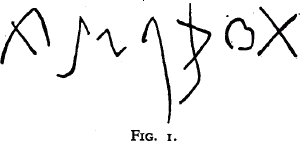Article contents
A New Interpretation of the Phoenician Graffito from Holt, Denbighshire
Published online by Cambridge University Press: 07 August 2014
Extract
The graffiti from the tilery and pottery which the Twentieth Legion maintained at Holt, Denbighshire, included one which Professor A. Guillaume acutely recognised as written in neo-Punic script. He rendered the text as M‘QR YTN (or M‘QR YNA) that is “Ma‘qar, (son of) Yathanbaal (or Yathanmilk)”. But a close study of the graffito, undertaken by the first-named writer of this note in conjunction with Professor H. F. D. Sparks, has shown that Professor Guillaume's alternative reading is to be preferred, and may be expressed as M‘QRYN’. The second and seventh letters, here transcribed as rough and smooth breathing respectively, represent the vowels, in this case, of a Latin word. The third letter will represent hard c, as Q (qoph) is often used to transcribe this sound in non-Semitic words. The fifth letter (yodh) would stand for long i. From the photograph the exact form of the final letter (aleph) is not clear, but can be seen by close inspection. The evidence, however, of the drawing (here given as Figure 1) was confirmed by a squeeze and shows how the straight stroke not only touches but actually intersects the other stroke and thus forms a cross with terminal hook, which was a common neo-Punic form of aleph.

- Type
- Research Article
- Information
- Copyright
- Copyright © The British Institute for the Study of Iraq 1955
References
1 Grimes, , Holt: the works-depot of the Twentieth Legion at Castle Lyons, (= Y Cymmroder xli (1930) 133 no. 26)Google Scholar.
2 Iraq, Vol. VII, p. 67, Plate VGoogle Scholar. The sherd is in the National Museum of Wales, Cardiff. The graffito was cut, after firing, on the wall of a bowl of coarse red ware of large diameter.
3 Cooke, , North Semitic Inscr. 140Google Scholar shows that ‘ayin could render short a, and ’aleph long o or long u.
4 Guillaume, loc. cit.
5 Made from the tile itself by the second-named writer for inclusion in Collingwood and Wright, The Roman Inscriptions of Britain.
6 Lidzbarski, , Handbuch der nordsemitischen Epigraphik ii, Plate XLIV, col. 25Google Scholar.
7 Professor G. R. Driver cited these and similar instances. See Friedrich, in Festschrift Eissfeldt (1947), 120 fGoogle Scholar.
8 Friedrich, op. cit., 116.
9 Ephemeris Epigr. IX. 1272Google Scholar; Grimes, 52, 142.
10 As pointed out by Mr. Eric Birley, who cites two inscriptions which cannot date earlier than the reign of Septimius Severus, (a) Corpus Inscriptionum Latinarum VIII, 5180, 17266Google Scholar, the tombstone of a soldier who died in Africa after serving in the Sixth Legion at York, and (b) C.I.L. VIII, 2080, 27966Google Scholar, a tombstone erected in Africa to the sister of Julius Victor, who had served with the Twentieth Legion at Chester.
11 On orthographic grounds the termination of the name which has been taken as a masculine could, with less probability, be regarded as a feminine name, Macrina. While this is much less likely, the possibility should be mentioned.
- 3
- Cited by




